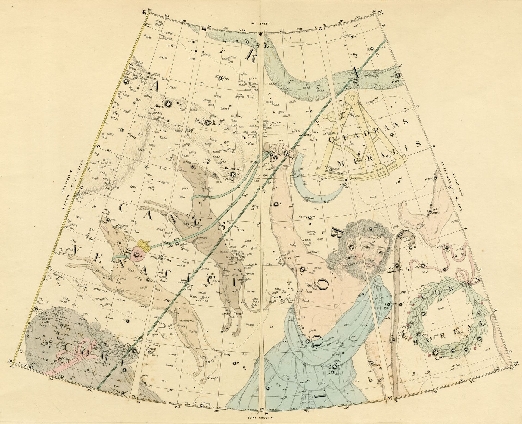
(Rare Books, RB Folio 523.89 MAL)
Malby’s Telescopic Companion or Celestial Globe-Atlas was published by the map and globe makers Malby & Co. in January, 1843. This handsome volume, with ornate gilt-decorated cloth binding, contains a set of twenty one striking double-page colour plates depicting the stars and constellations in the sky, as recorded by the many renowned astronomers who had identified and listed the stars throughout history.
The constellations into which the sky of the northern hemisphere has traditionally been divided were originally described by the Ancient Greeks, who likened each constellation to a mythological figure or sign of the zodiac, although the Latin forms of their names, rather than the Greek, have traditionally been used. The plates in Malby’s globe-atlas carry colourful artistic representations of these figures. This plate depicts the constellations Canes Venatici, Bootes and Ursa Major. The Canes Venatici (“hunting dogs”), Asterion and Chara, are held on a leash by Bootes the herdsman as they chase the Great Bear (Ursa Major), whose tail can be seen disappearing off to the left of the picture.
Malby’s globe-atlas actually served a dual purpose, as the atlas could either be used in its original form as a book or the sheets could be cut out and joined together according to the instructions provided to create a three-dimensional globe. The firm Malby & Co., established by Thomas Malby in c. 1839, was known for producing maps and globes of varying types and sizes, including table and pocket globes, and associated itself with the geographical publishing of the Society for the Diffusion of Useful Knowledge (SDUK).
The volume is apparently exceedingly rare; the British Library lists only a copy of the 1845 edition in its holdings and no other copies of this particular edition, which appears to be the first, are listed anywhere else.
Adding to its interest, the volume carries the bookplate of Hugh Lee Pattinson, the eminent metallurgical chemist and industrialist from the North-East of England who discovered the process of separating silver from lead, later known as the Pattinson Process. He was also the great grandfather of Gertrude Bell. The Latin motto on his coat of arms reads Ex Vile Pretiosa which means “Valuable things from base things”, an allusion to his momentous discovery.
